Sony A95L
Product Name: Sony A95L
Product Description: 2023 4K QD-OLED TV
-
Build Quality - 9.3/10
9.3/10
-
Image & Audio - 9.5/10
9.5/10
-
Connectivity - 9.2/10
9.2/10
-
OS & Smart Features - 9.5/10
9.5/10
-
Price / Quality - 8.9/10
8.9/10
Summary
Reviewed at $2,499.00 (55″)
Pros
- Breathtaking image quality
- Deep blacks
- Plenty of gaming features
- 4K@120Hz with Dolby Vision
Cons
- No 1440p or 144Hz support
- No FreeSync
- Only 2 HDMI 2.1 ports
- Noticeable motion stutter
Cheapest Places to Buy :
*We are a reader-supported website. When you buy through links on our site, we may earn a small affiliate commission at no extra cost to you. Home Media Entertainment does not accept money for reviews.*
Although a lot of Sony‘s new 2023 TV models are on the markets across the globe for some time one TV that got late to the party was their QD-OLED flagship. But finally the TV started to become widely available so there is no better time to check it out in our thorough Sony A95L review.
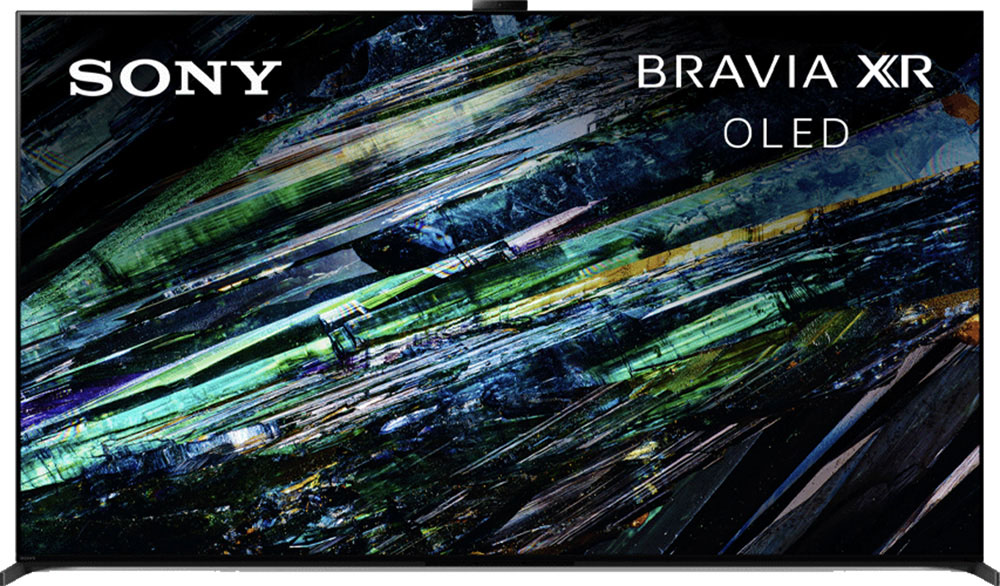
The A95L replaces the 2022 Sony A95K as their new crown jewel of the Bravia XR Master Series. Sony’s 2023 OLED lineup is relatively compact this year. With only the Sony A80L, that we already reviewed, and the now released A95L. By the way the new TV is the only QD-OLED available in Sony’s 2023 release lineup. But surely comes with a few key changes compared to last year’s release.
But before we go into more details let’s go over the specs real quick. The Sony A95L comes with a 2nd generation, 120Hz QD-OLED panel along with Cognitive Processor XR and Sony’s most advanced Acoustic Surface Audio+ system. There is Dolby Atmos, DTS and Dolby Vision support, two HDMI 2.1 ports with VRR out of the box, and comes with the latest Google TV platform that includes many extras like Chromecast, Airplay 2, Homekit, Bravia Core, voice control, Netflix calibrated mode, IMAX Enhanced, Calman Ready and Bravia Cam support.
Sony did a few key upgrades in the A95L that may not be so obvious from the above. But there is more to it than what the specs may show. So keep reading as we delve deeper into Sony’s flagship in order to determine if they have another winner in their hands this year.
Design
You would think that since the A95L is replacing the A95K these two would have many design similarities. Surprisingly the A95L looks much closer to the 2023 X95L than its predecessor.
For a flagship unit Sony made sure to keep the build quality at high levels. Plastic is obviously extensively used once again. But the whole unit feels very sturdy and nicely constructed. We didn’t notice any defects during our testing.
Measurements
Thickness of the TV is about 1.2″ (3.0 cm) which makes it even slimmer than the 2022 A95K. Obviously the QD-OLED panel helps with keeping the thickness to an absolute minimum. But its impressive that Sony further improved this.
Its borders were measured 0.28″ (0.7mm) making the screen look very immersive.
Back Side
Looking the back of the TV is where we saw most of the similarities to the Sony X95L. The A95L has little resemblance to the A95K here. The back features a checkerboard design which is very Sony like and extremely similar to the checkerboard designs of other Sony TVs.
All ports are on the right side in a single group looking sideways. The power connector is, as usual, on the left side. At the top we find the connector for the Bravia Cam which is sold separately. The rest of the back side is clear of any other elements and only the VESA wall mount holes are visible at the center.
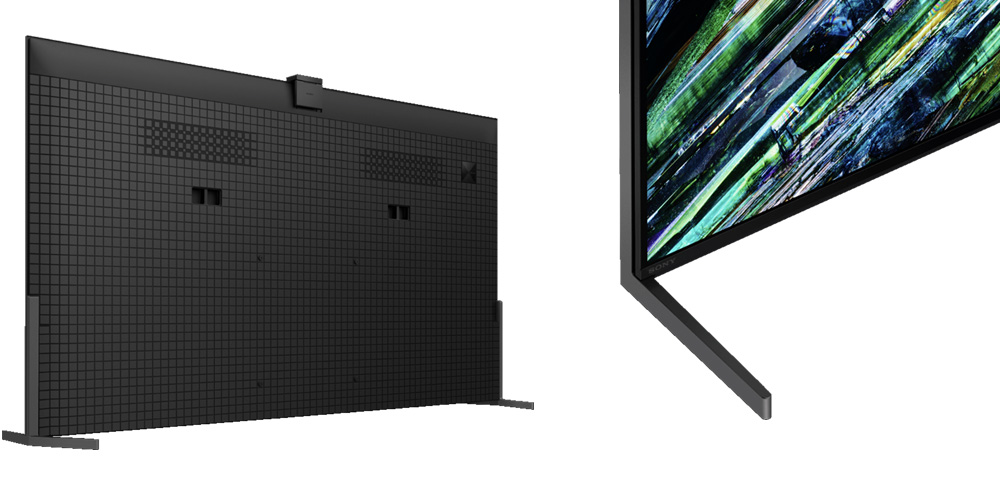
Stand
Sony decided to overhaul the stand design for the A95L and we believe this was the right decision. The weird stand design of the A95K has been abandoned for a more traditional bench type stand. In fact the one used seems to be exactly the same as the stand we saw in the X95L but with a small difference.
You are offered two positions with the A95L, the standard and soundbar positions. Both of them require the legs to be placed at the very edges of the screen meaning you will need a pretty big furniture for that. The soundbar position just raises the panel higher for a soundbar to fit under it.
Keep in mind that these two stand positions are available for the 55″ and 65″. The new 77″ offers a third position called the narrow one which allows you to place the legs closer. If only this was offered in the smaller units also.
As for its design the stand is made out of metal and is of good quality. But we still got some wobble, something to be expected for such a big TV. But nothing major to worry about. The back of the legs are creating an angle in order to disappear even when looking the TV off center.
Remote
As for the remote, this is exactly the same one we saw in some of the other 2023 Sony TVs.
Sony really found a nice balance for their buttons layout. It is not as cluttered with buttons as LG’s remotes are and is a bit more functional than Samsung’s One Remote. The number of buttons is just the right one and you will never feel troubled pressing the correct one.

The remote obviously comes with a built-in microphone for issuing your commands to the TV and also comes with six dedicated buttons instead of four available last year.
In the 2023 version you will find buttons for the usual Netflix, Amazon Prime, Disney Plus and Youtube. Sony also added their own Bravia Core Service and Chruncyroll. It appears that Crunchyroll is an online service for anime and manga so it makes sense to see this from Sony. But we really doubt how many will be using this except from very specific markets.
Video Quality
Processor technology used
In terms of image processing the A95L uses Sony’s best Cognitive Processor XR. This is the same chip used across most premium and top tier TVs from Sony.
The Cognitive Processor XR divides the screen into hundreds of zones and recognizes individual objects in these zones better than ever before. What’s more, it can cross-analyze around a few hundred thousand different elements that make up a picture in a second like focal points, contrast, colors, motion and clarity and determine ways in order to improve the end result even more.
Just from the naming you may think that Sony is reusing the same chip from previous years. In reality Sony made certain improvements in their processor this year, even though it uses the exact same name. These improvements, or additions if you like, are included in many of their top tier releases in 2023.
The new addition is called “XR Clear Image”. This new feature gets the input signal and cleans it up with its Signal Characteristics Analysis. This is checking resolution, encoding parameters and bitrate among others in order to apply its Adaptive Noise Resolution and Adaptive Super Resolution.
To make it simple to understand, this technology works with low quality streaming and broadcasting content in order to clean the image as much as possible. It can work in parallel with the TV’s upscaling features in order to give you an image that is up to 4K resolution standards. Although do not expect this to perfectly work across all content. But in certain cases the results can be rather impressive.

Resolution and Up-scaling
As always first comes our upscaling testing. We run a few videos in different resolutions ranging from ultra low quality ones, some 480p DVDs, some in 720p and obviously 1080p resolutions. We tried broadcasting signals, streaming content and discs to have a better, all around idea of the TV’s capabilities.
Sony proves again and again that they are one of the best in terms of image processing. And the A95L is another prime example of that. Low quality content looked really good. There was little loss of detail while the TV managed to clear a lot of the macro-blocking in the test content.
With lower resolution videos the A95L’s upscaling capabilities were noteworthy. The final 4K images retained a lot of details without any over-sharpening artifacts. While text was distinct enough across most sizes that appeared on screen.
Audio Processing
We will talk more about the A95L’s audio capabilities in our dedicated audio section. But the TV comes with all the standard audio features you expect to find in a Sony premium model.
As such we find the XR Sound suite which includes Sony’s Acoustic Surface Audio+ system. Along with it we get XR Surround for virtually created audio and Voice Zoom 2 which is a dialog enhancement feature.
Lighting technology used
As was the case with the 2023 Samsung S95C, the new Sony A95L uses a 2nd generation QD-OLED panel. And this new panel comes with certain improvements over the first implementation of this technology last year.

OLED Technology
Traditional OLED panels feature self emitting pixels. As a result these TVs have no need for a backlight as we see in LED LCD models. Being able to control it’s individual pixels has many advantages. The most obvious ones being the extremely accurate light control and the infinite contrast they have. Deep blacks on an OLED is a sight that you need to see to believe.
On the other hand the problem with OLEDs is that they cannot reach the high brightness output of LED LCD TVs. This has been a problem since the inception of OLED panels. And although there had been some developments like Panasonic’s solution to add a heatsink, in order to push the panel more without damaging it, OLEDs still remained a distant second when it came to peak brightness output.
And this is where Samsung’s QD-OLED comes into play. This hybrid design takes all the strengths that OLED has and mix them with Quantum Dot technology. This results in a boost in brightness and color reproduction to levels that were not possible with the panels available till now.
2nd Generation QD-OLED
Now, in its 2nd generation Samsung added a new layer on the panel featuring a much more efficient blue electroluminescent material. And the addition of its improved algorithms allows the new panel to reach higher white and color luminance. It also has better durability than its 2022 counterpart and lower power consumption.
One thing that we need to mention here one more time is that due to the unusual subpixel structure of QD-OLED you may notice some green or red lines in content that have black bars on top or bottom of the screen. Also because of this, using the A95L as a PC monitor may not be ideal as text will not appear as clear as in other panels. These are problems of the QD-OLED technology in general and have nothing to do with the A95L specifically.
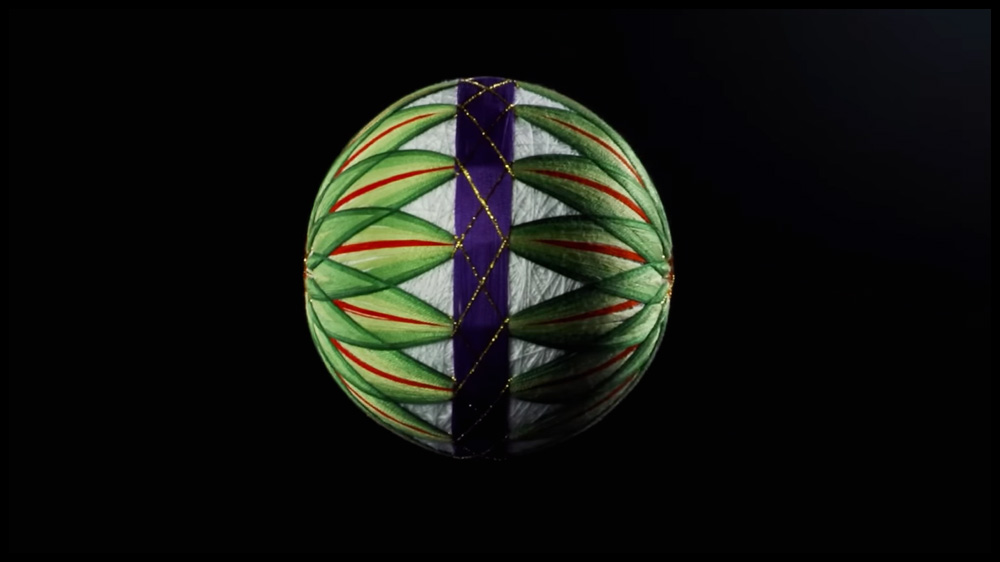
Blooming
In our blooming test patterns the A95L performed admirably and as good as any OLED TV we had tested before. Being able to see a bright object in a completely dark background and don’t have any blooming on sight is a real treat and shows how good QD-OLED technology is.
QD-OLED is an amazing evolution of OLED and if blooming is your number one concern then with the A95L you will not have to worry about it at all.
Brightness / Contrast
Next we will be looking at the brightness of the TV. In terms of settings we used the same ones as we do in most Sony models. For picture mode we selected Professional with maximum brightness and Peak Luminance.
Keep in mind that Professional mode replaced the Custom mode that we saw in previous Sony TVs. But it’s essentially the same one with a different name.
SDR and HDR Measurements
First test is the SDR brightness over a 10% window and the number we got was 487 nits which is good enough. With SDR the A95L may not be the brightest TV we have seen but it is enough for most light room conditions.
We then switched to HDR content and in our HDR brightness over a 10% window test we measured 1,105 nits. Great peak brightness for all kinds of HDR content and room conditions. Even if a bright highlight covers a large part of the screen the TV can pump out enough brightness to keep its intensity in extremely high levels.
From the above numbers the A95L is a clear improvement over the A95K.

Automatic Brightness Limiter (ABL)
As with most TVs, the A95L comes with an Automatic Brightness Limiter (ABL). This lowers the overall brightness of the screen when large parts of it become very bright for a long period of time. This may not be very obvious when watching a movie for example. But is more obvious with bright static images, or if you use the TV as a computer monitor.
The ABL on the A95L did kick in after setting a specific bright image for a long time. You don’t have to worry about this in normal viewing and it’s mostly notable when you compare images or if you use the TV as a computer monitor. Also the TV’s brightness is high enough that even when the ABL kicks in, it is bright enough to preserve most highlights.
EOTF Tracking
Brightness levels were extremely close to the EOTF reference values up to its relatively sharp roll-off point. Although the tracking is not perfect it is a close one and one of the most accurate ones we have seen.
As usual, for the A95L to follow the curve accurately you have to use its Gradation Preferred tone mapping as the other options are far less accurate.
The A95L performed really close to the A95K here.

Contrast Performance
As for contrast using a QD-OLED panel means that the A95L can switch off it’s pixels entirely. Just like OLED panels do. This means it gains almost infinite contrast ratio resulting in true deep blacks compared to greyish blacks we see in many LCD models.
Viewing angles
OLED TVs always had the upper hand when it came to viewing angles. And it seems that with QD-OLED things are even better now. Comparing the A95L to the A95K did not show any noticeable differences. The two TVs behaved almost the same. This is as good as it gets considering that last year’s model was already almost perfect in this area.
In general, light has a linearity, so when viewing a display, it affects the brightness or color depending on which angle you look at the screen. With the characteristic of QD-OLED to emit light uniformly in all directions, the QD display provides optimal image quality. It does that by delivering uniform luminance and color regardless of viewing angle.
As a result the A95L is capable of exceeding the viewing angle levels we see on most OLED TVs while keeping its image quality at almost the same level. Even at extreme angles of up to 70 degrees the image properties were almost the same as watching the TV dead center which was impressive to say the least.
With QD-OLED viewing angles are perfect. No major change here and to be honest there is hardly anything better that manufacturers can do here.

HDR support
HDR support has remained the same the last few years. As such the A95L features the standard trio of HDR formats. These are the basic HDR10 which is required for 4K UHD playback, HLG that is used in broadcasting and lastly the more advanced Dolby Vision that uses dynamic metadata and offers the best quality from the three available.
The only omission is HDR10+. But if you don’t care about it then you shouldn’t really worry. Dolby Vision has far more support, although HDR10+ seems to be getting some traction both from online streaming services like Amazon Prime and in the UHD format.
If you really want to have both HDR10+ and Dolby Vision then you will have to look at some other brand like Hisense, TCL or depending where you live at Panasonic or even Philips. Unfortunately none of the big three (LG, Samsung and Sony) support all three of them.
Color coverage
The A95L, just like the A95K, uses Sony’s XR Triluminos Max technology. This is a step above the Triluminos Pro tech that we find in many premium Sony TVs.
From our measurements the TV can reach almost 100% coverage of the DCI-P3 color space which is as good as it gets. On the wider REC.2020 color space we got a coverage of 89% which again is great.
From the numbers above the A95L seems to perform really close to the A95K. Last year’s model was already amazing and the new release keeps the same characteristics.

DeltaE Errors
Before calibration the TV had amazing color accuracy. All colors managed to stay under the DeltaE limit of three and gamma was really close to its target value. White balance and color temperature did need some adjusting but even with default settings they were more than acceptable.
After calibration the TV was even better than before. We managed to further improve the white balance and color temperature while everything else remained as good as before.
Obviously after calibration the TV performed far better. But even its out-of-the-box settings were extremely good. This surely will satisfy you either you are a casual user that doesn’t like to spend much time calibrating or if you like to get the most out of your TV.
Color Gradients
Color gradients were amazing with almost no visible banding at all. The A95L cannot get much better than this and follows the performance the A95K had.
As with many Sony TVs, there is also a Smooth Gradation feature in case you do notice some banding. But you are going to lose some fine detail if you use it, as is always the case with this feature. And to be honest, with the A95L you are not going to need this at all.

Panel Uniformity
Panel uniformity of the A95L was really good but not perfect. Most colors displayed perfectly but with a dark grey background we did notice some subtle vertical banding. This seems to be a known problem as many users have reported this.
Black uniformity on the other hand was perfect. There was no clouding or any other undesired effects on the screen.
Motion performance
Next we have our motion performance tests.
The A95L uses a 120Hz panel along with Sony’s XR OLED Motion technology. This is the company’s motion interpolation feature we find in the XR Picture feature set of the Cognitive Processor XR.
The A95L, being a QD-OLED, doesn’t need a backlight to light its pixels. While in theory this makes the TV flicker free in reality this is not the case but the flicker is so small that is not visible to the naked eye at all.
In terms of motion the TV did good with very little blur in fast action scenes. This is obviously a result of the A95L’s fast response times which is a well known OLED characteristic. On the other hand a lot of stutter shows up with low framerate content that you can fix only by enabling motion interpolation.
The TV can also remove judder either from 24p or 60p content, which is great for any kind of content.

Motion Interpolation
As we mentioned above, the TV comes with the usual motion interpolation feature. This can smooth motion and remove blur and judder from fast camera movements. Motion interpolation in the A95L was as good as in many other premium and top tier TVs.
Obviously in very demanding scenes we did see some artifacts. But we did expect this. And these were mostly due to the very fast camera movements, which is a problem with almost all TVs.
Obviously using very aggressive settings will make the “Soap Opera Effect” to appear so you have to adjust the settings accordingly. Motion Interpolation can be enabled by turning CineMotion to High and MotionFlow to Custom. From there you can adjust the Smoothness slider accordingly.
Black Frame Insertion (BFI)
Black Frame Insertion (BFI) is also available and can be enabled with the Clearness setting in the MotionFlow menu. With BFI the A95L was able to smooth motion considerably but you have to accept a few downsides this has.
The first is that brightness takes a visible hit. Which is detrimental with any TV that cannot achieve extremely high brightness output. Thankfully the A95L is bright enough, so this does not affect the final image too much.
The second is that BFI can work only with 60Hz. It doesn’t work with 120Hz so this means you cannot use it for 4K@120Hz gaming.

Overall Motion Impressions
Overall the TV behaved very similar to the A95K. It has its ups and downs as no TV is perfect. The TV is really good but does have some noticeable flaws because of the technology it uses. Some motion interpolation will fix some of those but make sure to find a nice balance that will not make motion look unnatural.
Input lag Measurements
Next we will test the TV’s input lag performance.
According to our measurements the A95L measured an average of 16.8ms input lag in both 1080p and 4K resolutions at 60Hz. Very good numbers here. At 120Hz we measured 8.5ms in both 1080p and 4K resolutions which again is great, even if not the best we have seen.
Sony TVs always had slightly higher input lag than both Samsung and LG, something we have seen in all their releases. So this comes to no surprise to us.
But the difference is relatively small, and gaming can really be a pleasure. Just make sure you use the available Game mode. As outside that the input lag will greatly increase to around 220ms which is far too high even for slow paced, offline gaming.
As with all Sony TVs the A95L does not support either 1440p resolution or 144Hz refresh rate. So 4K@120Hz is the best you can get. Keep that in mind as we start to see certain brands supporting either 1440p or 144Hz, or even both. Sony is always slow at adopting such features so let’s hope we see these next year.
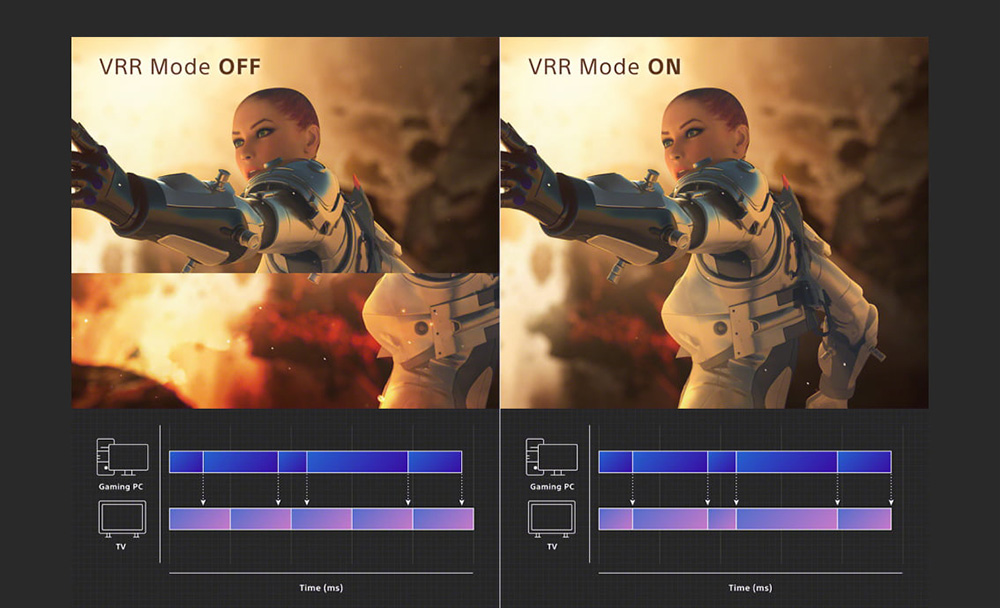
Other Gaming Features
We should also not forget to mention that the TV supports Auto Low Latency Mode (ALLM). This can be used with any devices that support that like the PS5 and Xbox consoles and can greatly benefit users.
Unfortunately, as with all Sony TVs there is no HGiG mode. But we do get Auto Genre Picture Mode and Auto HDR Tone Mapping which are Playstation 5 specific features.
Finally the A95L is the first Sony TV to support 4K@120Hz with Dolby Vision. This happens due to the TV using the new Pentonic 1000 HDMI chipset. This feature was missing from all previous Sony releases, including the A95K.
VRR Support
The A95L comes with VRR support out of the box, which Sony made standard last year. HDMI Forum VRR and G-Sync are supported but unfortunately not FreeSync. Sony is not supporting that in any of their releases so far. This is unacceptable to see in a flagship unit like this and we hope that Sony will finally rectify this in the future.
Trying Out a Few Games
As we usually do, to get a feel of the TV’s responsiveness we connected both our PS5 and Xbox series X to one of the HDMI 2.1 ports of the A95L. The games of choice are F1 2022 which supports both 60Hz and 120Hz and Dead Space which is a 60Hz game only.
In both games the TV appeared to be extremely responsive. Especially with F1 2022 which needs fast reflexes and reactions we didn’t sense the TV to be slow to our commands. Everything registered on screen immediately. With Dead Space we had a very smooth experience but its slower nature makes it a more forgiving experience with reaction times.
The A95L, as with all Sony TVs, may be missing a few specific gaming features like 1440p, 144Hz and FreeSync. On the other hand we finally got 4K@120Hz with Dolby Vision. It may not be able to compete directly to LG or Samsung in terms of features. But as far as performance is concerned the TV did really great.

Overall Image Quality Impressions
The 2022 A95K was a very impressive first release of QD-OLED for Sony. And they managed with the new A95L to improve in certain areas. The most obvious of course is brightness as the A95L scored obviously better than its predecessor. The XR Clear Image feature is a nice one for certain situations while the new Pentonic 1000 HDMI chipset allows the TV to finally support 4K@120Hz with Dolby Vision.
From all the above we can say with certainty that the new A95L is a clear improvement this year.
Audio Quality
When it comes to audio Sony has developed several technologies that uses in their TVs and the one that is included in the A95L is their most advanced one called Acoustic Surface Audio+. This is the same system that we saw in both the A95K and the 2023 A80K but with a slightly different configuration applied here.
This system basically uses actuators at the back of the panel that vibrate and use the whole panel as a huge membrane and thus create sound. This way it seems like audio is coming from within the screen giving you a better sense of realism.
Audio System – Channels & Power Rating
The TV uses a 2.2 channels configuration with 60 watts of power output. Power distribution is 20 W + 20 W + 10 W + 10 W.
It is a bit puzzling why the lower tier A80L is using a 3.2 channels system while the flagship A95L comes with a less capable 2.2 channels one. But these are the exact same configurations the 2022 A95K and A80K had so there is no real changes from last year.
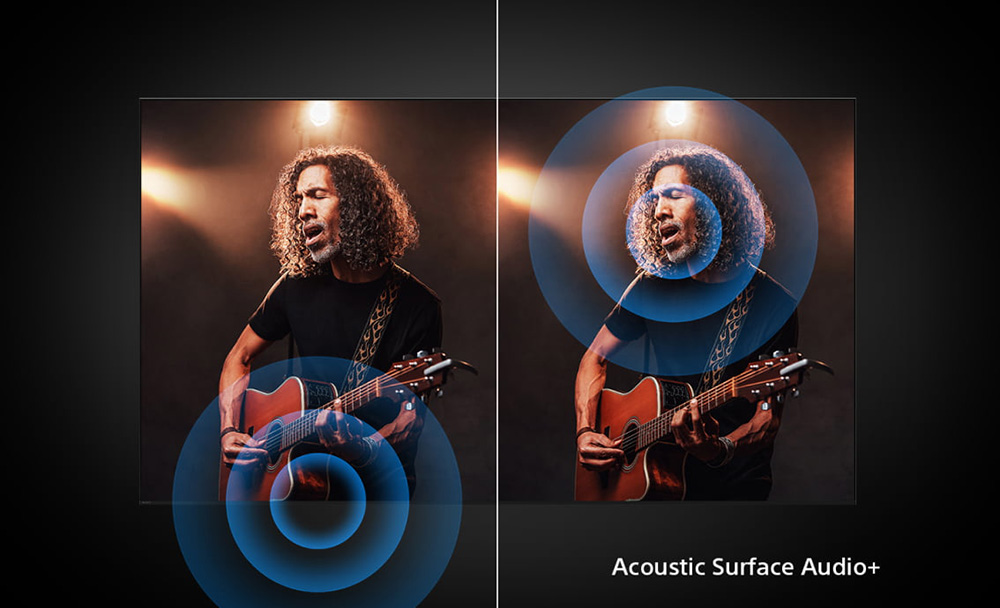
Audio Formats Support
There is support for Dolby Audio, Dolby Atmos and DTS Digital surround sound. But even with all these technologies the TV cannot create a fully immersive experience like a true surround system can. As it lacks the necessary hardware, like height and rear speakers, the final sound output lacks a lot in comparison.
Also keep in mind that Sony supports DTS and can even pass-through both Dolby Atmos and DTS:X signals from its eARC port. So if this important to you then the Sony is one of your definite choices.
Since last year Sony was the only of the big three (Samsung, LG, Sony) to still support DTS. But LG brought it back in 2023 in some of their top tier models, upping the competition considerably. Samsung is the only brand that does not support DTS at all right now.
Audio Features
There are plenty of audio features that Sony included here so let’s go over what you are getting.
First we have XR Surround. With it the A95L is using 3D surround upscaling in order to create a more immersive virtual surround environment. This is done by using two of Sony’s proprietary virtual technologies. The first one is called S-Force Front Surround which is responsible for creating virtual surround sound. The second one is Vertical Surround Engine which is responsible for over the head audio like Atmos effects.
Also present is Voice Zoom 2 which is Sony’s dialog enhancement technology. This feature detects voices and after analyzing them uses special filtering to suppress ambient sounds. This way even subtle dialog is greatly enhanced.
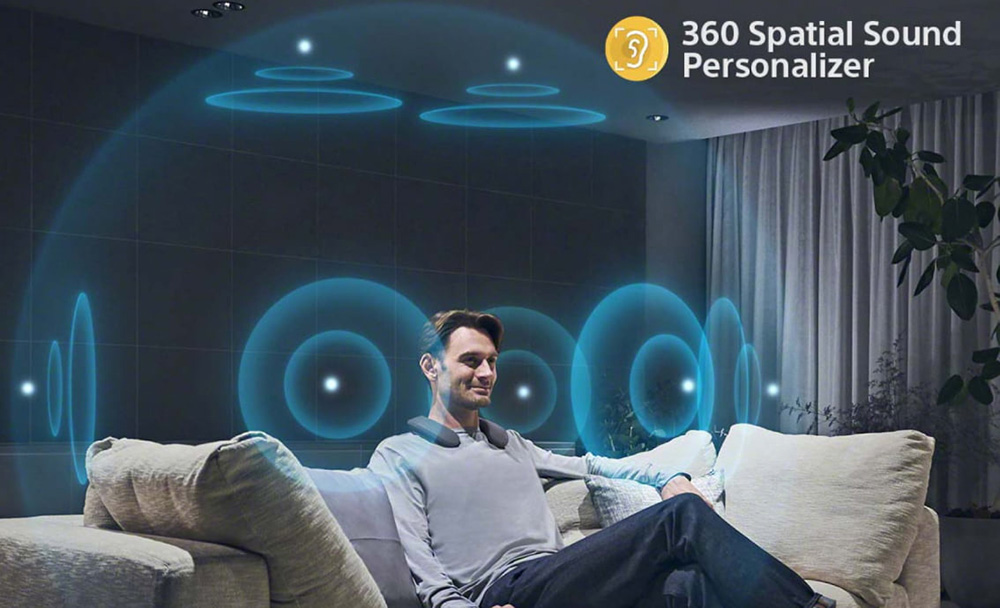
A couple more features is Sony’s Acoustic Center Sync and 360 Spatial Sound Personalizer. With the first you can combine the TV with a Sony soundbar for a more synchronized output. The second can be used in combination with other speakers, like the SRS-NS7 wearable speaker, for spatial sound.
The A95L naturally features Sony’s Acoustic Auto calibration in order to get the best audio performance no matter your sitting position. This can be used in combination with the optional Bravia Cam as it will detect where you sit in the room and calibrate the audio accordingly.
Overall Audio Performance Impressions
The A95L’s performance is not so much different from many other top tier TVs either from Sony or competing brands. Yes, its quality is a step above all those simple 2.0 channels systems but if you really want immersive surround sound you are not going to get that with just the TV.
And to be honest with the A95L’s amazing image quality you do need an audio system that can really make it justice. For casual viewing like broadcasting and sports the TV can do just fine. But if watching movies is your thing then make yourself a favor and buy a good surround system. Or a Dolby Atmos capable soundbar at the very least.
Ports and Connectivity
Next we will be looking at all the connection ports available.
The A95L uses a ports layout that is very similar to the one the X95L uses. As all ports are grouped together on the right side looking sideways.
Going from top to bottom you get the center speaker inputs and two USB ports for connecting external storage or powering various devices. There is also a hybrid digital optical audio output / S-Center speaker input port depending what you are going to use it for.
Beneath we find four HDMI ports for connecting all your devices. We also get an Ethernet port for wired connection to your network, an RS-232C port for control, an IR input and the usual antenna/cable connector.
HDMI Specifications
With the A95L using the new Pentonic 1000 HDMI chipset many were hoping that Sony will finally be getting four HDMI 2.1 ports in their TVs. Unfortunately this turned out to be false hopes as the new chipset can still do only two HDMI 2.1 ports but with a few added features.
And to make matters even worse one of them is also the one with ARC/eARC functionality. So if you plan on using that then you are left with a single HDMI 2.1 port. In general all TVs that feature only two ports use Mediatek’s SoCs. At least the HDMI 2.1 ports in the A95L provide full 48Gbps bandwidth in order to allow high frame rate gaming and all HDMI 2.1 gaming features.
The HDMI 2.1 ports support ARC, eARC, HFR, ALLM, VRR and for the first time 4K@120Hz with Dolby Vision. With VRR both HDMI Forum VRR and G-Sync are available out of the box, something that applies for all 2023 Sony models. FreeSync VRR on the other hand is not supported by Sony at all.
Connectivity Observations
Again, the Ethernet port is still the usual 100Mbps one. But this does not surprise us, as we have yet to see a TV making the transition to Gbit adapters.
Streaming requirements and internet connections have greatly advanced the last few years. This made the 100Mbps limit obsolete a while back. And while most TVs update their WiFi capabilities (some models including the A95L even support WiFi6 this year) the Ethernet adapters are still the same.
And considering that the A95L comes with Bravia Core, Sony should be at the forefront of this much desired change. We say this because Bravia Core’s highest quality Pure Stream available at 80Mbps require a minimum internet speed of 115Mbps. So in essence you cannot do that with a wired connection and have to rely on wireless with all the problems this can bring.
And lastly Sony, unlike some of the other big manufacturers, actually provide a USB 3.0 port in most of their TVs. Usually manufacturers don’t seem very fond of using the newer USB ports. And rely mostly on the archaic 2.0 version even for many of their top premium models. So having one is definitely a plus.
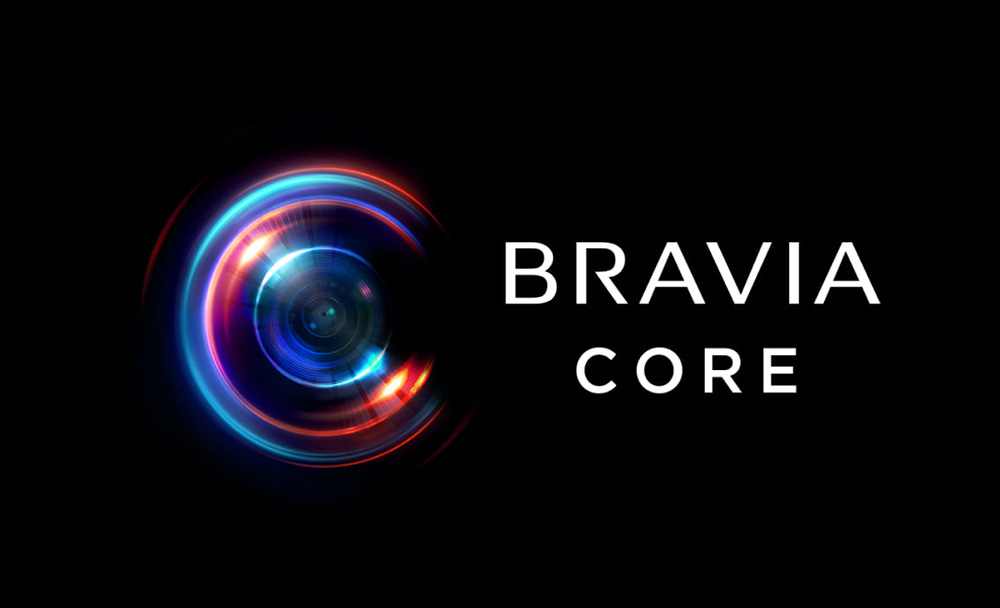
Wireless Capabilities
When it comes to its wireless capabilities the Samsung A95L got a small upgrade over the A95K. It now supports WiFi6 (802.11ax) along with Bluetooth 5.2. Sony is finally starting to catch up.
OS, Apps and Features
As the A95L appeared a bit late on the market compared to most other models it probably gave the time to Sony to add the latest Google TV which is version 12.0.
But to be honest the last few versions of Google TV do not have major differences between them and they keep their overall layout unchanged.
Google TV 12.0
Google has done a poor job at making clear of the differences between Google TV and Android TV that is still being used from some TV brands.
To make things real simple Google TV is still Android TV but with an extra layer on top of it. Think of it like how it works with Android smartphones. Most manufacturers that use Android in their releases they use on top of that their own layer that gives this extra something to their UI that make them unique both in appearance and functionality.
The same is with Google TV. You still basically use Android TV but there is the extra Google TV layer on top in order to make the UI feel different both in looks and functionality.

Google TV seems to have been designed around recommendations, either it be movies, TV shows or applications and this seems to be the main focus of all the latest OS in general. During setup the wizard asks you of what specific streaming services you use in order to customize the Home screen recommendations.
Keep in mind that Google TV is still Android at its core even though it looks different from Android TV. But with Google TV things seem more fluent, more direct and more easy to navigate around.
As far as navigation and overall user experience the A95L was really good most of the time. And we say this because while during navigation through all the menus and settings our experience was butter smooth there were a few instances when the whole OS would slow down. This would happen only for a few seconds in specific moments but we did experienced it more than once. Hopefully a future update will iron this out.
Streaming Capabilities
If there is one thing that Google TV has in abundance that is huge app support. Through the included Google Play Store you can find literally thousands of apps that you can download and use. Except from the pre-installed ones of course. There is so much content available that you will hardly miss anything.
All the big names are obviously present like Google TV, Disney+, Netflix, Amazon Video, Hulu, HBO Max, Apple TV and Youtube. There is also Pandora, Tidal, Google Play Music, Spotify and iHeartRadio to name a few.

As always some of them are region dependent so make sure the ones you are interested in are working in your area. Lastly many apps like Netflix and Youtube support playback for both 4K and HDR content for those interested in it. But since each app is different we cannot say which apps support what resolutions and HDR formats in various regions.
Various Connectivity Features
Chromecast is also available here and it gives you the ability to stream content from other Chromecast enabled devices like mobile phones and tablets directly to the TV.
We also get support for both Apple Airplay 2 and HomeKit, which is now named Apple Home. With Airplay 2 you can stream content from other Apple devices on your TV while Apple Home lets you control certain aspects of the TV through your mobile device.
Voice Control
Voice control is also present as per normal. The TV can work with both Google Assistant and Amazon Alexa. You also have the ability to use Apple’s Siri through Apple Home in case you prefer Apple’s solution.
Built-in Media Player
As with most TVs nowadays the A95L can playback a wide range of files and codecs through its USB port. We tested the TV by trying a selection of files we keep for this reason. The files we tried were various combinations of video and audio codecs and the results were very good considering this is a built-in media player.
Most files would playback normally. But this applied mostly to files that used the more common codecs. If you try to use a file that has a less common codec combination or if the bitrate is unnaturally high you will definitely have problems with it.
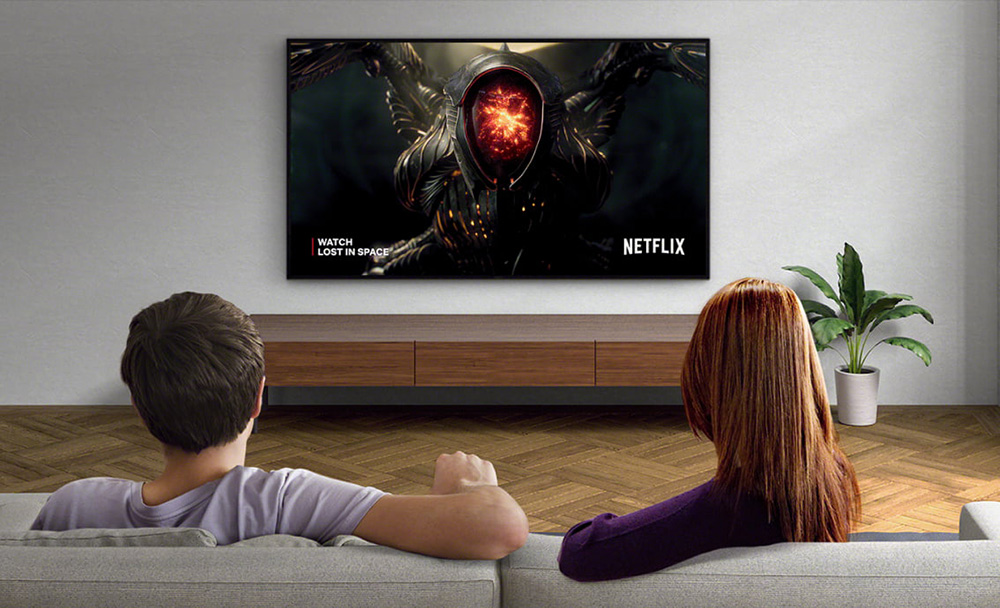
Netflix Adaptive Calibrated Mode
The A95L also comes with the Netflix Adaptive Calibrated Mode which we also saw in some other top tier Sony TVs. What this does is to allow you to experience picture quality close to a filmmaker’s vision and intent for all content that is streamed through the Netflix streaming service.
This feature works together with the ambient light optimization feature of the A95L by optimizing the picture brightness based on your room lighting conditions.
Calman Ready
For one more year many Sony TVs, including the A95L, are Calman Ready. To address color variations from the production process, the TV is ready to use Portrait Displays’ high-performance Calman auto-calibration software.
This allows an unprecedented level of calibration and the ability to fine-tune adjustments simply not possible through conventional picture settings. It delivers high-fidelity color reproduction that’s true to the original TV signal, and can even adapt to the subtlest changes in color that may occur over time.
Bravia Cam
Bravia Cam is another returning feature. This is an optional accessory that can be purchased separately and can further enhance the functionality of this TV.
With the Bravia Cam the A95L can detect where you sit in the room and adjust the picture and audio accordingly. Other functions include gesture control and power saving features among others.
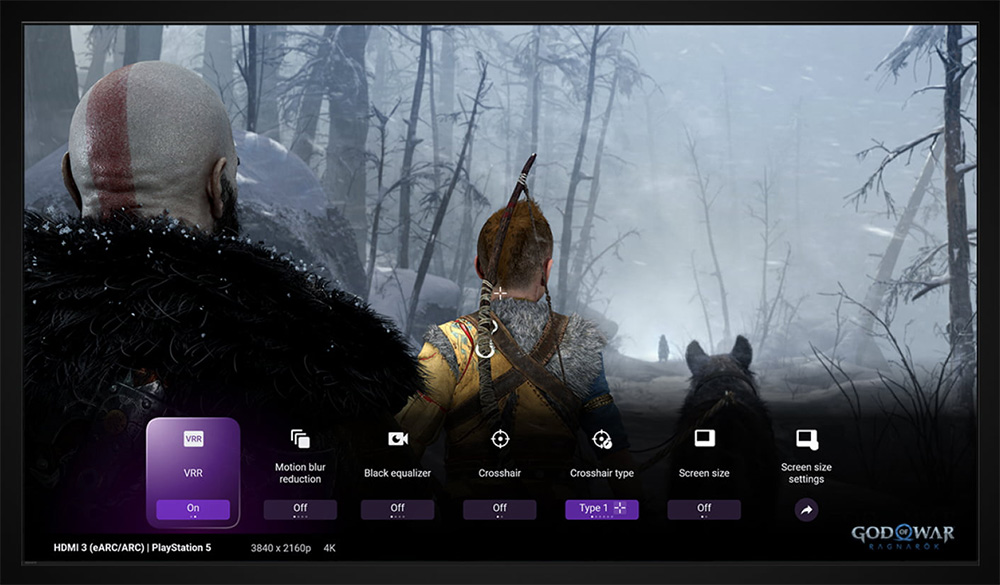
Game Menu and Eco Dashboard
It took some time to implement something similar to what the other competing brands have but finally Sony made it, even if they are the last ones to do it.
The new Game Menu offers you the ability to gain access to certain gaming features like VRR, screen size settings and picture features. And all of this with a press of a button.
The Game menu feels less refined than LG’s and Samsung’s implementations but keep in mind that this is Sony’s first year for rolling out this feature. As happened with the other brands, now that it’s out they will surely update and refine it in future releases.
Also new this year is the Eco Dashboard. This allows you to change energy settings but also indicate you how these settings affect power consumption. Everything through a single, comprehensive screen.
Compared to other TVs
The first obvious comparison is to the 2022 Sony A95K. The A95L is better overall with an updated QD-OLED panel, an improved Cognitive Processor XR, the new Pentonic 1000 HDMI chipset that allows 4K@120Hz with Dolby Vision, upgraded WiFi and Bluetooth and a new 77″ size.
The other obvious comparison is with the 2023 Samsung S95C which is the only other QD-OLED to also uses the 2nd generation QD-OLED panel. Here things are not so clear. The Sony is better with image processing and supports Dolby Vision. The Samsung on the other hand is slightly brighter and has better gaming features like 144Hz and FreeSync support along with 4 HDMI 2.1 ports.
Lastly you may wonder how the A95L stacks up against LG’s flagship, the 2023 LG G3 OLED. Again here there is no clear winner. The LG has slightly better brightness, supports FreeSync and comes with 4 HDMI 2.1 ports. The Sony on the other hand has better processing, higher color coverage and better out-of-the-box accuracy.
Honorable mentions go to Hisense U8K and TCL QM8/QM850G. Although these two 2023 TVs are not of the OLED type, their performance and value make them deserve at least a mention. Keep in mind that both of them cost almost half the price of the Sony A95L. But their performance for being mini-LED TVs are noteworthy. If you want affordable flagship performance then you may want to consider them also.

Final Thoughts
Sony already had a very solid release with their 2022 A95K. But this year with the development of the 2nd generation QD-OLED panel along with minor other upgrades Sony managed to offer a clear improvement over what they released last year.
The Sony A95L has everything it needs to be a true flagship. Breathtaking image quality, stellar image processing, OLED rated blacks, plenty of gaming features, low input lag and Google TV with a plethora of offline and online features.
But as no TV is perfect neither is the A95L. The TV is missing a few features we find in competing brands like 1440p and 144Hz support along with FreeSync. Sony still has to do with only two HDMI 2.1 ports while motion performance was less than stellar with some very obvious stuttering. Lastly we would like the third narrow stand position to be included in the smaller sizes also.
Closing our Sony A95L review we can say that Sony really outdid themselves this year. They took everything that was good with the A95K and made enough changes for the new A95L to be definitely a step to the right direction. And for that we highly recommend it.
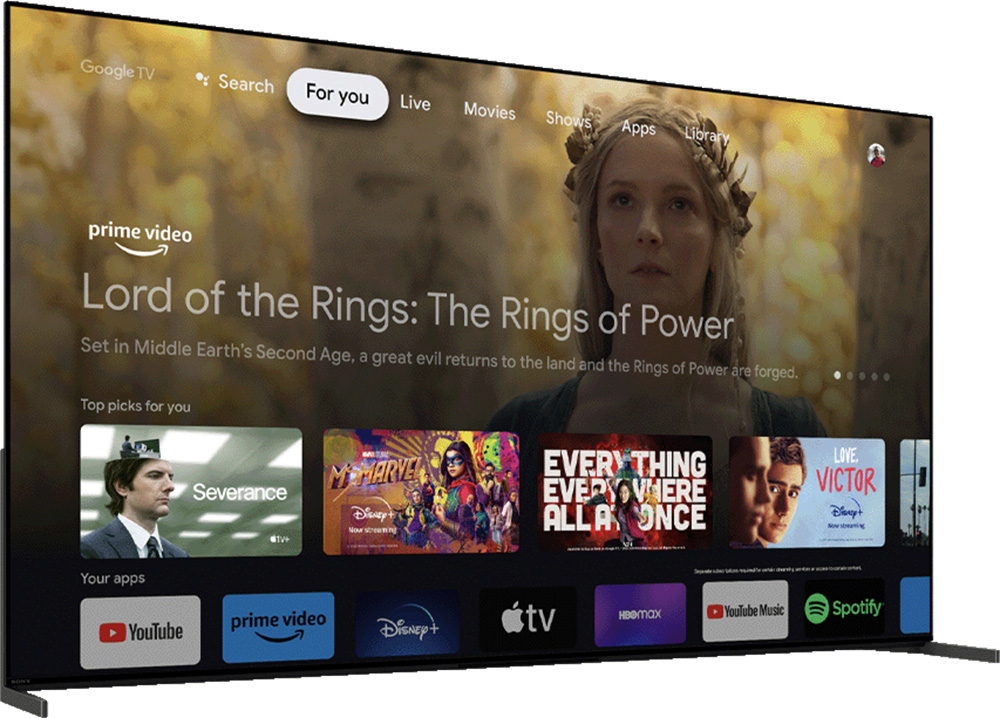
For more reviews you can check our dedicated 4K QD-OLED TV reviews list or even look at our Product Reviews Table where you can find the brand and specific product you are looking for.
Cheapest Places to Buy :
*We are a reader-supported website. When you buy through links on our site, we may earn a small affiliate commission at no extra cost to you. Home Media Entertainment does not accept money for reviews.*








Hi Stratos,
Finally you reviewed the A95L! I was really waiting for it. I am a big Sony fan but this year competition is huge. I cannot laterally make up my mind between the A95L, the S95C and the G3 OLED. In the end I think I will go with Sony as they never disappointed me.
Best regards,
Makhsud
Hey there. All three flagships are really good this year. It is a tough decision. But if you are all Sony then the A95L will not disappoint you.
Hi there! Nice review on the A95L. Sony proved once again they know how to make a good flagship. Good quality, few ways of installing it in the living room, many features, and you have described everything with every single detail! I would take this over Samsung any time. Thanks a lot again.
Kind regards,
Błażej
Hey there. It is indeed a great TV. If only it was a bit cheaper. But this is what you have to pay for a Sony product.